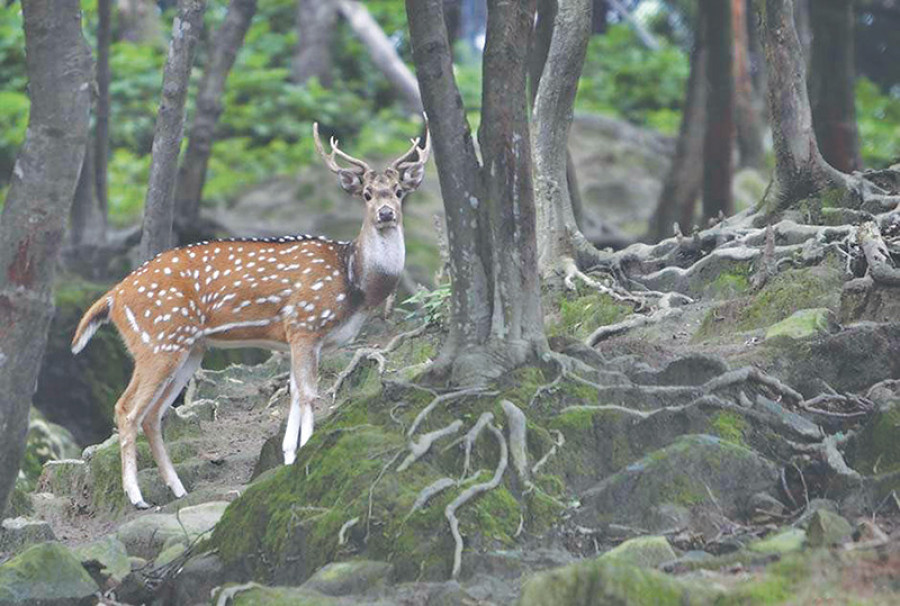Opinion
Small fish and scapegoats
In January 2015, the police arrested Rajkumar Praja, a 31-year-old Chepang from Korak VDC, Chitwan, for killing over a dozen rhinos and smuggling two rhino horns. He was arrested by Interpol in Malaysia and extradited to Nepal.
Shradha Ghale
In January 2015, the police arrested Rajkumar Praja, a 31-year-old Chepang from Korak VDC, Chitwan, for killing over a dozen rhinos and smuggling two rhino horns. He was arrested by Interpol in Malaysia and extradited to Nepal.
Conservation groups and agencies welcomed the news of Praja’s arrest with jubilation. They described him as the “kingpin” and “ringleader” of a major poaching network. National and international organisations posted his photos on their websites with triumphant headlines. One of them declared that Praja’s arrest boosted the “global fight against wildlife crime” and praised the Nepal government’s commitment to the cause.
Praja received a 15-year jail sentence and multiple fines worth several lakhs of rupees. The notorious criminal had got what he deserved. Good had won over evil.
A mere foot soldier
A news report published two years later somewhat complicated the narrative. On March 20, 2017, Republica carried a front-page report titled “Three generations into rhino poaching, Prajas dirt poor still.” It turned out Praja was not the only Chepang from Korak serving a lengthy jail term. A large number of people from the Chepang village, including Praja’s brothers and relatives, were languishing in prison for alleged wildlife offenses.
Praja’s family lived in destitution. His wife and parents worked 12 hours a day and struggled to make ends meet. His children walked more than an hour to reach school. His youngest brother, released after five years in prison, had not returned home. His oldest brother Dal Bahadur was serving a 10-year jail sentence.
According to Dal Bahadur’s wife Pabitra Maya, her husband had just returned from abroad when the police arrested him. “He had nothing to do with this business,” she said. The family wanted to appeal the court decision but had no money to pay lawyers.
One would expect a family involved in such a lucrative crime to have amassed a fortune over the years. A high-profile, notorious poaching ringleader would have at least built a comfortable home for his family. So why did the Prajas live in such abject poverty?
Because, said the news report, Praja was one of the “mere foot soldiers” in a vast and complex network of illegal wildlife traders. Deliberately or otherwise, those who celebrated his arrest did not mention this. Unlike those higher up in the wildlife trade hierarchy, the Prajas lacked access to power or political protection.
And so the likes of Rajkumar Praja get captured, named and shamed, “while the actual masterminds, who take all the benefit, remain untouched.”
Praja’s story is just one example of how Nepal’s conservation laws catch flies but let hornets go free.
It is no secret that illegal trade in wildlife and forest products cannot thrive without the nexus between politicians, forest officials, security forces and traders. In 2008, for instance, four of the nine rhino poachers arrested in Bardiya National Park were Nepal Army personnel (Gorkhapatra, June 9, 2008).
There have been many reports of top politicians pressuring forest officials to release poachers and smugglers. Government officials, political leaders, security personnel, and hotels are among the main buyers of illegal bush meat in Nepal. Further, most rhinos in Nepal were killed near hotels and security check posts inside national parks, and not around buffer zones and community forests.
The National Parks and Wildlife Conservation Act, which remains an instrument of persecution against the poor local and indigenous people, allows wealthy hoteliers to run their businesses inside the park. (A 2012 study showed that 86 percent of the hotels in Sauraha, the main tourist hub of Chitwan, are run by hill migrants, with the Tharus occupying low-level positions such as waiters, cooks and dishwashers.) Well-funded poachers can use such services to enter protected areas and carry out their illegal activities.
One more favour
Despite the involvement of so many powerful actors, a disproportionate number of those arrested for wildlife related crimes belong to poor and marginalised groups. According to Prabhat Kiran Sewa Samaj, a Chitwan-based NGO, 151 people were locked up in Bharatpur district prison for alleged wildlife related crimes as of January-February 2015.
In the previous year alone, the Department of National Parks and Wildlife Conservation arrested 142 people for wildlife offenses. Of them, 73 had been falsely accused. Among the 142 arrested, 64 were Chepang. The rest belonged to other indigenous groups such as Kumal, Bote and Tharu—communities that had been living in the forests of Chitwan long before the park was established in 1973. The history of Chitwan National Park is also a history of violence and injustice against these communities.
In 2009 three Chepang men in Bharatpur prison were interviewed for a study commissioned by Transparency International Nepal. They had all been charged with wildlife offenses and expressed “grave concern” over the maximum punishment: a 15-year jail sentence and a fine of NPR 100,000. One of them was especially worried about his brother, whose case remained undecided even though he had been in custody for three years. All three men complained that the park authorities harass the poor locals but “allow the high-level traders to roam free.” They also asked the whereabouts of “those who took the wildlife products.”
And yet the authors of the same report can’t help repeating that “poor locals, ethnics and illiterates” carry out most of the wildlife offenses. The report contains sentences like: “In 1996 a trader was caught having killed seven rhinoceros in Bardia. He was local dweller from a Gurung community.” The “investigative” report is quick to project entire ethnic communities as misguided criminals. But it doesn’t name a single politician, government officer, or security official who might be complicit in the crime.
Perhaps this is understandable. The report describes how park officials who try to apprehend high-level criminals receive anonymous threats. In 2007, a Bardiya-based park official on his way to Gularia was chased by motorcyclists. In 2008,
custom officials at Tatopani had to flee from smugglers’ agents and hide under a truck on a cold winter night. “There is a greater chance of counter attack in cases where high profile individuals are targeted,” says the report.
So who are the authorities left with? “Poor locals, ethnics and illiterates.” Small fish and scapegoats who can neither defend themselves nor chase them on motorcycles. They can arrest them, fine them, throw them in jail and use their photos in their success stories. As someone once wrote, “As long as society bows and cringes before the great thieves, there will be little ones enough to fill the jails.”
We have learned about poachers from the poor and marginalised communities. We know their names and surnames and have seen their faces. Now, perhaps, conservation authorities and wildlife campaigners should do us another favour. Reveal the identities of those higher up in the supply chain of wildlife trade. And do specify their caste/ethnicity to put things into perspective.
- Ghale, a former op-ed editor at the Kathmandu Post, is a freelance writer




 12.12°C Kathmandu
12.12°C Kathmandu










